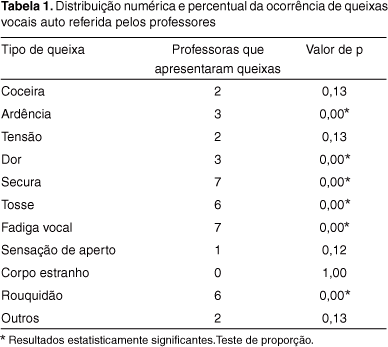PURPOSE: The aim of this study was to survey vocal complaints and degree of dysphonia among teachers from a public elementary school at Betim, MG (Brazil). METHODS: Thirteen elementary school teachers with ages between 20 and 50 years (mean of 36 years old), who taught at least 20 hours a week, participated in the study. Data were obtained using a questionnaire and voice recording, analyzed on the GRAM 5.7 acoustic analysis program. After acoustic analysis, the voices were perceptually analyzed and classified by three speech therapists with at least five years of clinical experience in the area. RESULTS: From the selected teachers, 30.77% showed normal voice quality, while 23.08% were considered to have mild dysphonia and 46.15% moderate dysphonia. None of the subjects showed severe dysphonia. Confidence intervals of 95% provided estimations of a minimum of 6.6% of teachers with discrete dysphonia and 22.39% with moderate dysphonia in the population of reference. Regardless of the type of vocal complaint, the total number of complaints among teachers with moderate dysphonia was significantly higher than among teachers with normal voice quality. Nevertheless, there were no differences between groups in the distribution of specific complaints, when these were individually analyzed. CONCLUSION: The majority of the teachers in this study had altered vocal quality, mostly being classified with moderated degree dysphonia. Specific vocal complaints appear to be equally distributed among teachers with normal voice and with dysphonia. Results point out the importance of vocal health projects directed to this population.
Voice; Phonation; Voice quality; Voice disorders; Occupational diseases


